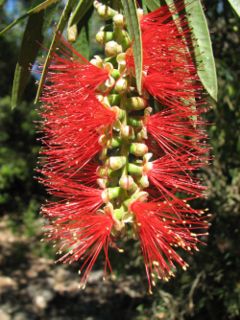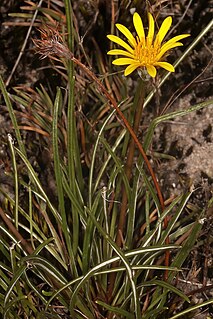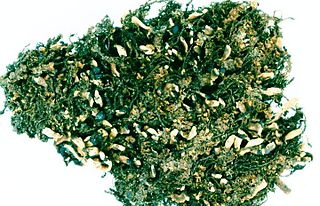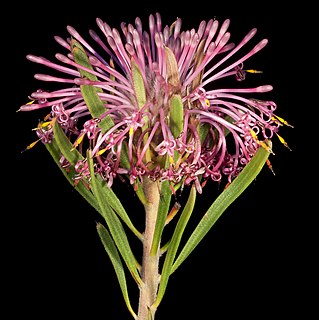
Callistemon is a genus of shrubs in the family Myrtaceae, first described as a genus in 1814. The entire genus is endemic to Australia but widely cultivated in many other regions and naturalised in scattered locations. Their status as a separate taxon is in doubt, some authorities accepting that the difference between callistemons and melaleucas is not sufficient for them to be grouped in a separate genus.

The fawn-footed mosaic-tailed rat, or fawn-footed melomys is a species of rodent in the family Muridae. It is found along eastern coastal regions of Australia.

Gazania linearis is a species of flowering plant in the family Asteraceae known by the common name treasure flower, or striped treasure flower, native to South Africa.

Cetradonia is a lichen genus in the family Cladoniaceae. A monotypic genus, Cetradonia contains the single species Cetradonia linearis. The genus was circumscribed in 2002 by Jiang-Chun Wei and Teuvo Ahti. The genus was once placed in the family Cetradoniaceae until that family was subsumed into the Cladoniaceae in 2006.

Astelia is a genus of flowering plants in the recently named family Asteliaceae. They are rhizomatous tufted perennials native to various islands in the Pacific, Indian, and South Atlantic Oceans, as well as to Australia and to the southernmost tip of South America. A significant number of the known species are endemic to New Zealand. The species generally grow in forests, swamps and amongst low alpine vegetation; occasionally they are epiphytic.
P. linearis may refer to:

Adenanthos macropodianus, commonly known as gland flower, or Kangaroo Island gland flower, is a species of shrub in the family Proteaceae. It is endemic to Kangaroo Island in South Australia. First published as a variety of A. sericeus in 1870, it was promoted to species rank in 1978.

Persoonia linearis, commonly known as the narrow-leaved geebung, is a shrub native to New South Wales and Victoria in eastern Australia. It reaches 3 m (9.8 ft), or occasionally 5 m (16 ft), in height and has thick, dark grey papery bark. The leaves are, as the species name suggests, more or less linear in shape, and are up to 9 cm (3.5 in) long, and 0.1 to 0.7 cm wide. The small yellow flowers appear in summer, autumn and early winter, followed by small green fleshy fruit known as drupes. Within the genus Persoonia, it is a member of the Lanceolata group of 58 closely related species. P. linearis interbreeds with several other species where they grow together.
Utricularia linearis is a carnivorous plant belonging to the genus Utricularia. It is known only from a single unnamed lagoon in Howard Springs, Northern Territory, Australia.
Adenanthos labillardierei is a species of erect shrub endemic to the slopes of the Barren Ranges in the Fitzgerald River National Park in southwest Western Australia.

Adenanthos linearis is a shrub of the family Proteaceae, native to the south coast of Western Australia. Within the genus Adenanthos, it lies in the section Adenanthos and has had only 14 known occurrences; only five of which have exact coordinates.

Caprella linearis is a species of skeleton shrimp in the genus Caprella. It is native to the North Atlantic, North Pacific, and the Arctic Ocean. It closely resembles Caprella septentrionalis with which it shares the same geographical distribution.
Catalepidia is a genus of a sole described species of medium-sized trees, constituting part of the plant family Proteaceae. The species Catalepidia heyana grows naturally only in a restricted mountain region (endemic) of the wet tropics rain forests of north-eastern Queensland, Australia. Common names include Hey's nut or Hey's nut oak.

Rhyncharrhena is a genus of plants in the Apocynaceae first described as a genus in 1859 by Ferdinand von Mueller. It contains only one known species, Rhyncharrhena linearis, native to Australia, which is found in all mainland states and territories.
Strangea linearis is a shrub of the family Proteaceae native to eastern Australia.
Strangea stenocarpoides is a shrub of the family Proteaceae native to Western Australia.

Strangea cynanchicarpa is a shrub of the family Proteaceae native to Western Australia.

Hakea linearis is a shrub or tree in the family Proteacea and is endemic to Western Australia. It has smooth branches, mostly linear leaves and white flowers.

Isopogon linearis is a small shrub in the family Proteaceae that is endemic to the southwest of Western Australia.
Pandorea linearis is a species of flowering plant in the family Bignoniaceae and is endemic to Queensland. It is similar to Pandorea pandorana but has nine to thirteen linear leaflets, the lateral leaflets 11–42 mm (0.43–1.65 in) long and 1.5–6 mm (0.059–0.236 in) wide.













